Analysis of Tourism Consumer Behaviour and Insight (L5) - Report
VerifiedAdded on 2023/01/19
|13
|4289
|27
Report
AI Summary
This report provides a comprehensive analysis of tourism consumer behavior and insights, focusing on the factors that influence consumer decisions within the tourism sector, using Thomas Cook Group as a case study. It examines cultural, social, personal, and psychological influences, and explores how digital technology is altering consumer trends, including changes in customer care and relationship management. The report delves into the stages of consumer decision-making, from need recognition to post-purchase evaluation, and explains the importance of mapping the customer's purchasing path. It covers the application of marketing mix elements and technological factors in influencing consumer decisions. Furthermore, the report compares B2C and B2B hospitality decision-making processes and evaluates different market research approaches, concluding with an assessment of how marketers can impact each stage of the tourism decision-making process.
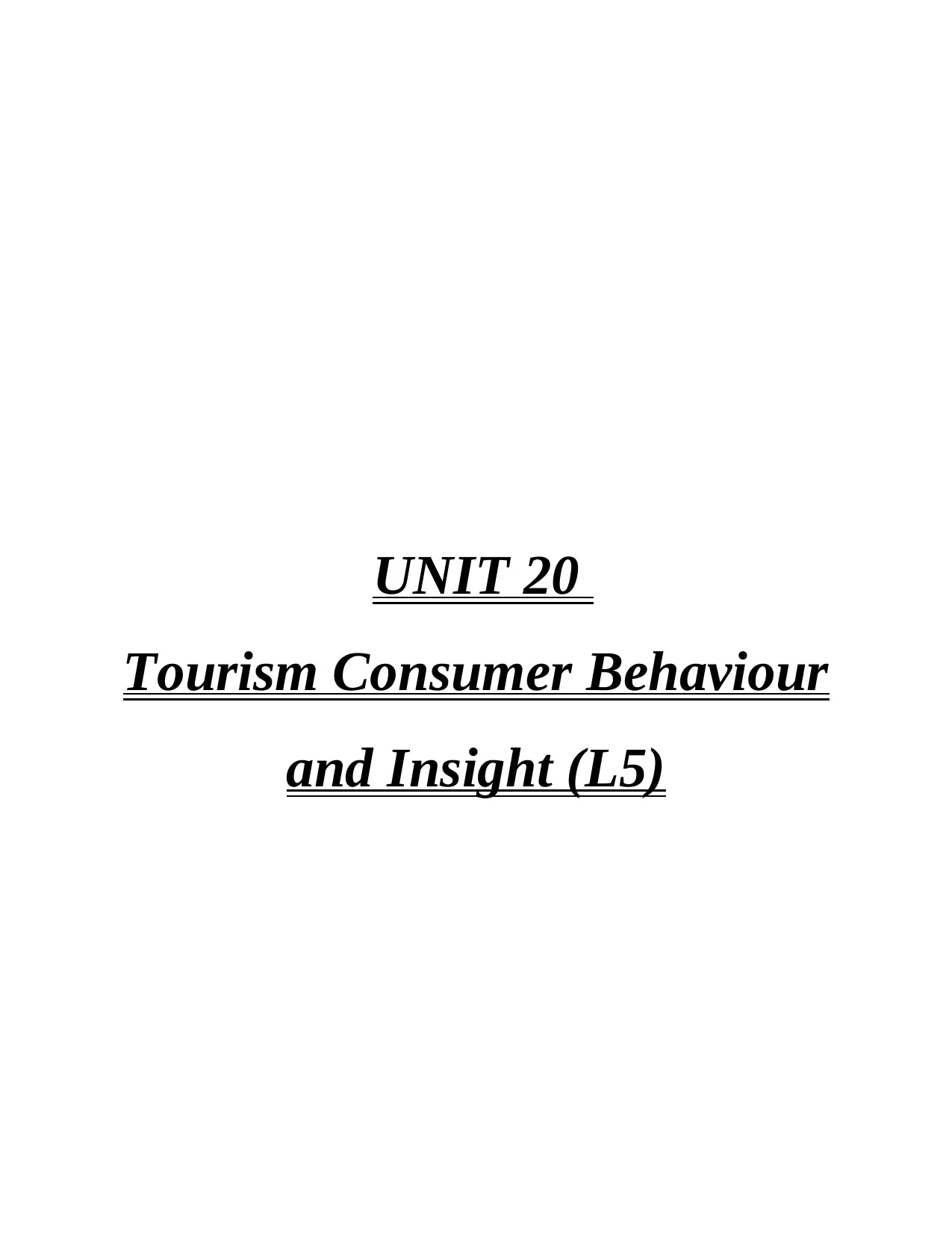
UNIT 20
Tourism Consumer Behaviour
and Insight (L5)
Tourism Consumer Behaviour
and Insight (L5)
Paraphrase This Document
Need a fresh take? Get an instant paraphrase of this document with our AI Paraphraser
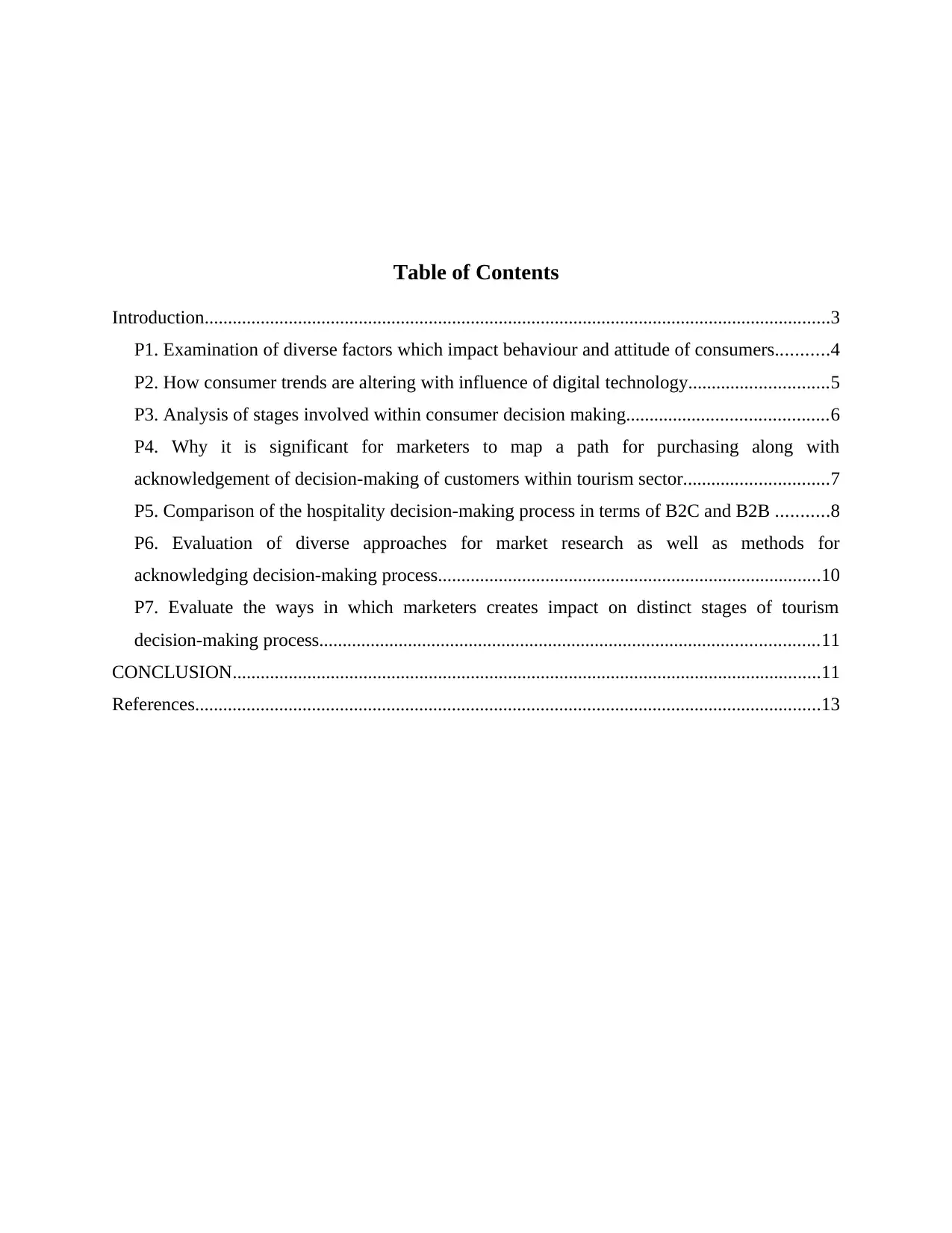
Table of Contents
Introduction......................................................................................................................................3
P1. Examination of diverse factors which impact behaviour and attitude of consumers...........4
P2. How consumer trends are altering with influence of digital technology..............................5
P3. Analysis of stages involved within consumer decision making...........................................6
P4. Why it is significant for marketers to map a path for purchasing along with
acknowledgement of decision-making of customers within tourism sector...............................7
P5. Comparison of the hospitality decision-making process in terms of B2C and B2B ...........8
P6. Evaluation of diverse approaches for market research as well as methods for
acknowledging decision-making process..................................................................................10
P7. Evaluate the ways in which marketers creates impact on distinct stages of tourism
decision-making process...........................................................................................................11
CONCLUSION..............................................................................................................................11
References......................................................................................................................................13
Introduction......................................................................................................................................3
P1. Examination of diverse factors which impact behaviour and attitude of consumers...........4
P2. How consumer trends are altering with influence of digital technology..............................5
P3. Analysis of stages involved within consumer decision making...........................................6
P4. Why it is significant for marketers to map a path for purchasing along with
acknowledgement of decision-making of customers within tourism sector...............................7
P5. Comparison of the hospitality decision-making process in terms of B2C and B2B ...........8
P6. Evaluation of diverse approaches for market research as well as methods for
acknowledging decision-making process..................................................................................10
P7. Evaluate the ways in which marketers creates impact on distinct stages of tourism
decision-making process...........................................................................................................11
CONCLUSION..............................................................................................................................11
References......................................................................................................................................13
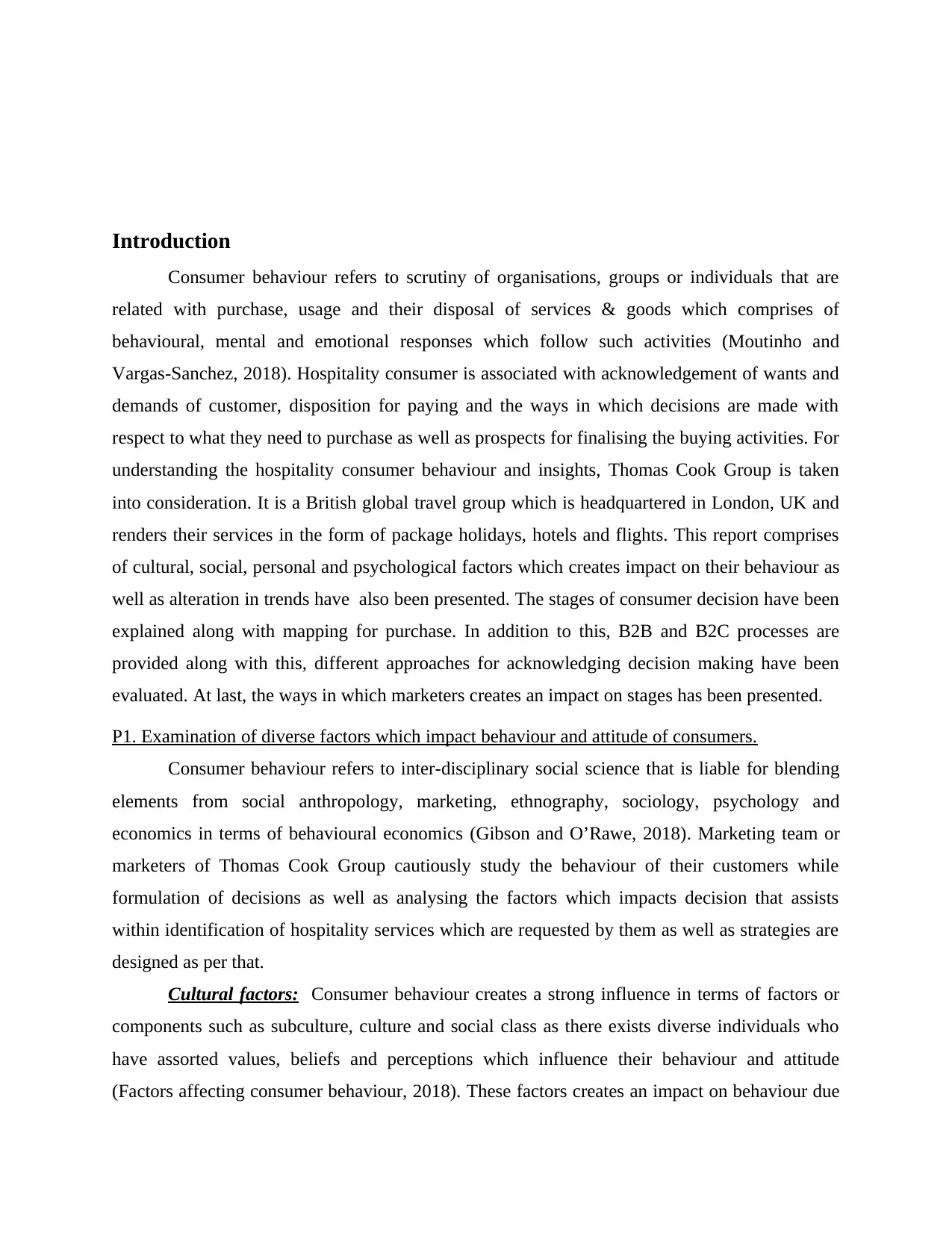
Introduction
Consumer behaviour refers to scrutiny of organisations, groups or individuals that are
related with purchase, usage and their disposal of services & goods which comprises of
behavioural, mental and emotional responses which follow such activities (Moutinho and
Vargas-Sanchez, 2018). Hospitality consumer is associated with acknowledgement of wants and
demands of customer, disposition for paying and the ways in which decisions are made with
respect to what they need to purchase as well as prospects for finalising the buying activities. For
understanding the hospitality consumer behaviour and insights, Thomas Cook Group is taken
into consideration. It is a British global travel group which is headquartered in London, UK and
renders their services in the form of package holidays, hotels and flights. This report comprises
of cultural, social, personal and psychological factors which creates impact on their behaviour as
well as alteration in trends have also been presented. The stages of consumer decision have been
explained along with mapping for purchase. In addition to this, B2B and B2C processes are
provided along with this, different approaches for acknowledging decision making have been
evaluated. At last, the ways in which marketers creates an impact on stages has been presented.
P1. Examination of diverse factors which impact behaviour and attitude of consumers.
Consumer behaviour refers to inter-disciplinary social science that is liable for blending
elements from social anthropology, marketing, ethnography, sociology, psychology and
economics in terms of behavioural economics (Gibson and O’Rawe, 2018). Marketing team or
marketers of Thomas Cook Group cautiously study the behaviour of their customers while
formulation of decisions as well as analysing the factors which impacts decision that assists
within identification of hospitality services which are requested by them as well as strategies are
designed as per that.
Cultural factors: Consumer behaviour creates a strong influence in terms of factors or
components such as subculture, culture and social class as there exists diverse individuals who
have assorted values, beliefs and perceptions which influence their behaviour and attitude
(Factors affecting consumer behaviour, 2018). These factors creates an impact on behaviour due
Consumer behaviour refers to scrutiny of organisations, groups or individuals that are
related with purchase, usage and their disposal of services & goods which comprises of
behavioural, mental and emotional responses which follow such activities (Moutinho and
Vargas-Sanchez, 2018). Hospitality consumer is associated with acknowledgement of wants and
demands of customer, disposition for paying and the ways in which decisions are made with
respect to what they need to purchase as well as prospects for finalising the buying activities. For
understanding the hospitality consumer behaviour and insights, Thomas Cook Group is taken
into consideration. It is a British global travel group which is headquartered in London, UK and
renders their services in the form of package holidays, hotels and flights. This report comprises
of cultural, social, personal and psychological factors which creates impact on their behaviour as
well as alteration in trends have also been presented. The stages of consumer decision have been
explained along with mapping for purchase. In addition to this, B2B and B2C processes are
provided along with this, different approaches for acknowledging decision making have been
evaluated. At last, the ways in which marketers creates an impact on stages has been presented.
P1. Examination of diverse factors which impact behaviour and attitude of consumers.
Consumer behaviour refers to inter-disciplinary social science that is liable for blending
elements from social anthropology, marketing, ethnography, sociology, psychology and
economics in terms of behavioural economics (Gibson and O’Rawe, 2018). Marketing team or
marketers of Thomas Cook Group cautiously study the behaviour of their customers while
formulation of decisions as well as analysing the factors which impacts decision that assists
within identification of hospitality services which are requested by them as well as strategies are
designed as per that.
Cultural factors: Consumer behaviour creates a strong influence in terms of factors or
components such as subculture, culture and social class as there exists diverse individuals who
have assorted values, beliefs and perceptions which influence their behaviour and attitude
(Factors affecting consumer behaviour, 2018). These factors creates an impact on behaviour due
⊘ This is a preview!⊘
Do you want full access?
Subscribe today to unlock all pages.

Trusted by 1+ million students worldwide
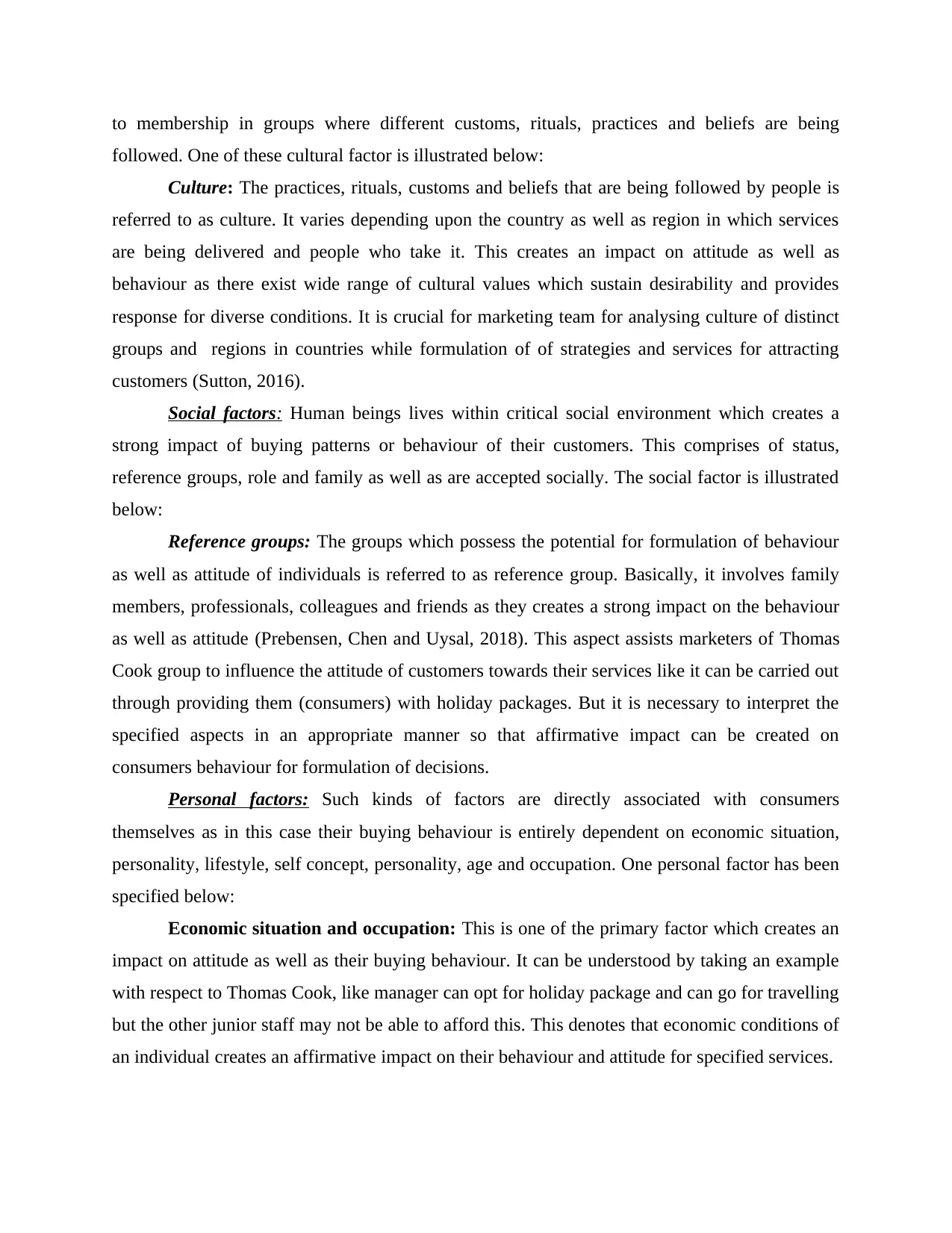
to membership in groups where different customs, rituals, practices and beliefs are being
followed. One of these cultural factor is illustrated below:
Culture: The practices, rituals, customs and beliefs that are being followed by people is
referred to as culture. It varies depending upon the country as well as region in which services
are being delivered and people who take it. This creates an impact on attitude as well as
behaviour as there exist wide range of cultural values which sustain desirability and provides
response for diverse conditions. It is crucial for marketing team for analysing culture of distinct
groups and regions in countries while formulation of of strategies and services for attracting
customers (Sutton, 2016).
Social factors: Human beings lives within critical social environment which creates a
strong impact of buying patterns or behaviour of their customers. This comprises of status,
reference groups, role and family as well as are accepted socially. The social factor is illustrated
below:
Reference groups: The groups which possess the potential for formulation of behaviour
as well as attitude of individuals is referred to as reference group. Basically, it involves family
members, professionals, colleagues and friends as they creates a strong impact on the behaviour
as well as attitude (Prebensen, Chen and Uysal, 2018). This aspect assists marketers of Thomas
Cook group to influence the attitude of customers towards their services like it can be carried out
through providing them (consumers) with holiday packages. But it is necessary to interpret the
specified aspects in an appropriate manner so that affirmative impact can be created on
consumers behaviour for formulation of decisions.
Personal factors: Such kinds of factors are directly associated with consumers
themselves as in this case their buying behaviour is entirely dependent on economic situation,
personality, lifestyle, self concept, personality, age and occupation. One personal factor has been
specified below:
Economic situation and occupation: This is one of the primary factor which creates an
impact on attitude as well as their buying behaviour. It can be understood by taking an example
with respect to Thomas Cook, like manager can opt for holiday package and can go for travelling
but the other junior staff may not be able to afford this. This denotes that economic conditions of
an individual creates an affirmative impact on their behaviour and attitude for specified services.
followed. One of these cultural factor is illustrated below:
Culture: The practices, rituals, customs and beliefs that are being followed by people is
referred to as culture. It varies depending upon the country as well as region in which services
are being delivered and people who take it. This creates an impact on attitude as well as
behaviour as there exist wide range of cultural values which sustain desirability and provides
response for diverse conditions. It is crucial for marketing team for analysing culture of distinct
groups and regions in countries while formulation of of strategies and services for attracting
customers (Sutton, 2016).
Social factors: Human beings lives within critical social environment which creates a
strong impact of buying patterns or behaviour of their customers. This comprises of status,
reference groups, role and family as well as are accepted socially. The social factor is illustrated
below:
Reference groups: The groups which possess the potential for formulation of behaviour
as well as attitude of individuals is referred to as reference group. Basically, it involves family
members, professionals, colleagues and friends as they creates a strong impact on the behaviour
as well as attitude (Prebensen, Chen and Uysal, 2018). This aspect assists marketers of Thomas
Cook group to influence the attitude of customers towards their services like it can be carried out
through providing them (consumers) with holiday packages. But it is necessary to interpret the
specified aspects in an appropriate manner so that affirmative impact can be created on
consumers behaviour for formulation of decisions.
Personal factors: Such kinds of factors are directly associated with consumers
themselves as in this case their buying behaviour is entirely dependent on economic situation,
personality, lifestyle, self concept, personality, age and occupation. One personal factor has been
specified below:
Economic situation and occupation: This is one of the primary factor which creates an
impact on attitude as well as their buying behaviour. It can be understood by taking an example
with respect to Thomas Cook, like manager can opt for holiday package and can go for travelling
but the other junior staff may not be able to afford this. This denotes that economic conditions of
an individual creates an affirmative impact on their behaviour and attitude for specified services.
Paraphrase This Document
Need a fresh take? Get an instant paraphrase of this document with our AI Paraphraser
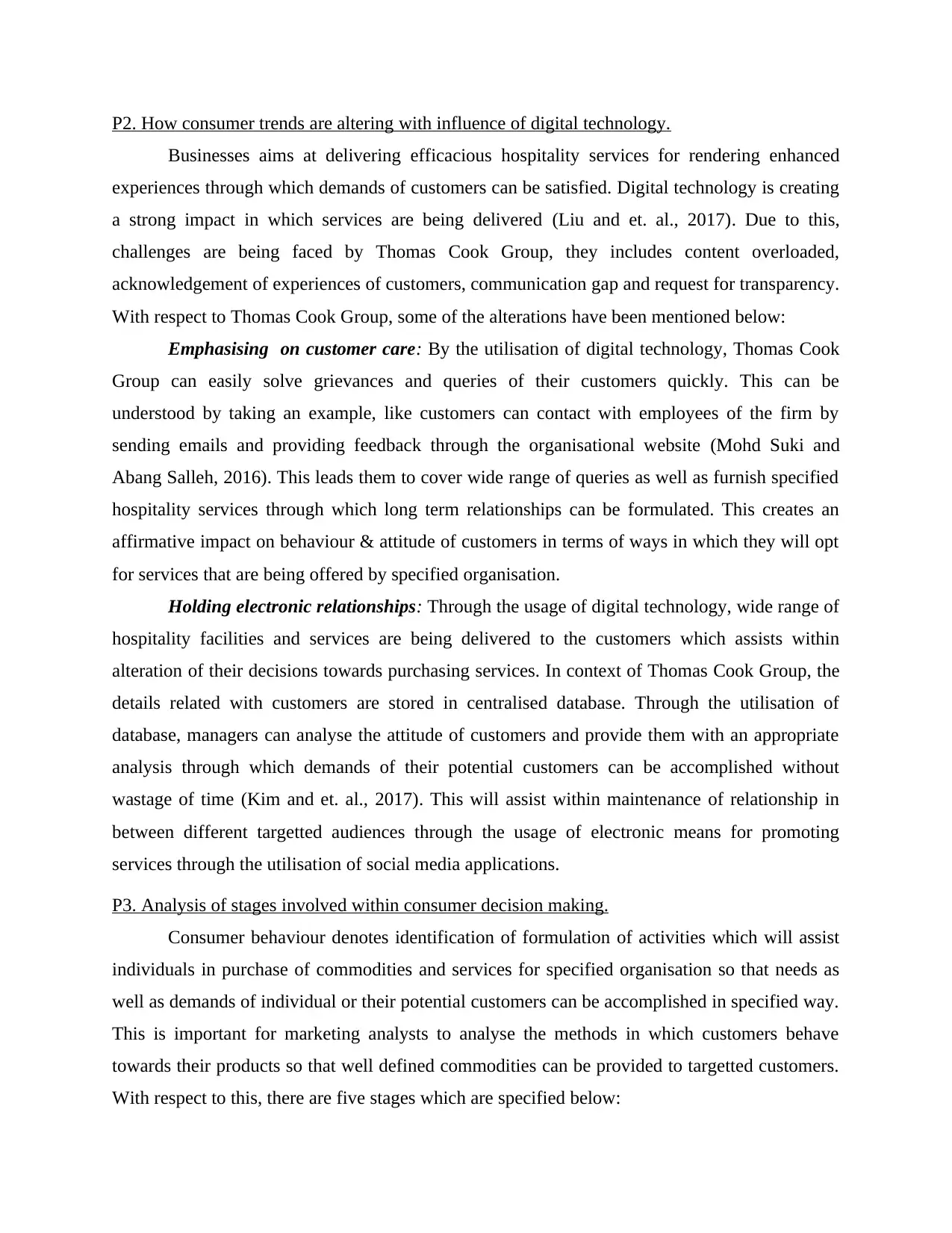
P2. How consumer trends are altering with influence of digital technology.
Businesses aims at delivering efficacious hospitality services for rendering enhanced
experiences through which demands of customers can be satisfied. Digital technology is creating
a strong impact in which services are being delivered (Liu and et. al., 2017). Due to this,
challenges are being faced by Thomas Cook Group, they includes content overloaded,
acknowledgement of experiences of customers, communication gap and request for transparency.
With respect to Thomas Cook Group, some of the alterations have been mentioned below:
Emphasising on customer care: By the utilisation of digital technology, Thomas Cook
Group can easily solve grievances and queries of their customers quickly. This can be
understood by taking an example, like customers can contact with employees of the firm by
sending emails and providing feedback through the organisational website (Mohd Suki and
Abang Salleh, 2016). This leads them to cover wide range of queries as well as furnish specified
hospitality services through which long term relationships can be formulated. This creates an
affirmative impact on behaviour & attitude of customers in terms of ways in which they will opt
for services that are being offered by specified organisation.
Holding electronic relationships: Through the usage of digital technology, wide range of
hospitality facilities and services are being delivered to the customers which assists within
alteration of their decisions towards purchasing services. In context of Thomas Cook Group, the
details related with customers are stored in centralised database. Through the utilisation of
database, managers can analyse the attitude of customers and provide them with an appropriate
analysis through which demands of their potential customers can be accomplished without
wastage of time (Kim and et. al., 2017). This will assist within maintenance of relationship in
between different targetted audiences through the usage of electronic means for promoting
services through the utilisation of social media applications.
P3. Analysis of stages involved within consumer decision making.
Consumer behaviour denotes identification of formulation of activities which will assist
individuals in purchase of commodities and services for specified organisation so that needs as
well as demands of individual or their potential customers can be accomplished in specified way.
This is important for marketing analysts to analyse the methods in which customers behave
towards their products so that well defined commodities can be provided to targetted customers.
With respect to this, there are five stages which are specified below:
Businesses aims at delivering efficacious hospitality services for rendering enhanced
experiences through which demands of customers can be satisfied. Digital technology is creating
a strong impact in which services are being delivered (Liu and et. al., 2017). Due to this,
challenges are being faced by Thomas Cook Group, they includes content overloaded,
acknowledgement of experiences of customers, communication gap and request for transparency.
With respect to Thomas Cook Group, some of the alterations have been mentioned below:
Emphasising on customer care: By the utilisation of digital technology, Thomas Cook
Group can easily solve grievances and queries of their customers quickly. This can be
understood by taking an example, like customers can contact with employees of the firm by
sending emails and providing feedback through the organisational website (Mohd Suki and
Abang Salleh, 2016). This leads them to cover wide range of queries as well as furnish specified
hospitality services through which long term relationships can be formulated. This creates an
affirmative impact on behaviour & attitude of customers in terms of ways in which they will opt
for services that are being offered by specified organisation.
Holding electronic relationships: Through the usage of digital technology, wide range of
hospitality facilities and services are being delivered to the customers which assists within
alteration of their decisions towards purchasing services. In context of Thomas Cook Group, the
details related with customers are stored in centralised database. Through the utilisation of
database, managers can analyse the attitude of customers and provide them with an appropriate
analysis through which demands of their potential customers can be accomplished without
wastage of time (Kim and et. al., 2017). This will assist within maintenance of relationship in
between different targetted audiences through the usage of electronic means for promoting
services through the utilisation of social media applications.
P3. Analysis of stages involved within consumer decision making.
Consumer behaviour denotes identification of formulation of activities which will assist
individuals in purchase of commodities and services for specified organisation so that needs as
well as demands of individual or their potential customers can be accomplished in specified way.
This is important for marketing analysts to analyse the methods in which customers behave
towards their products so that well defined commodities can be provided to targetted customers.
With respect to this, there are five stages which are specified below:
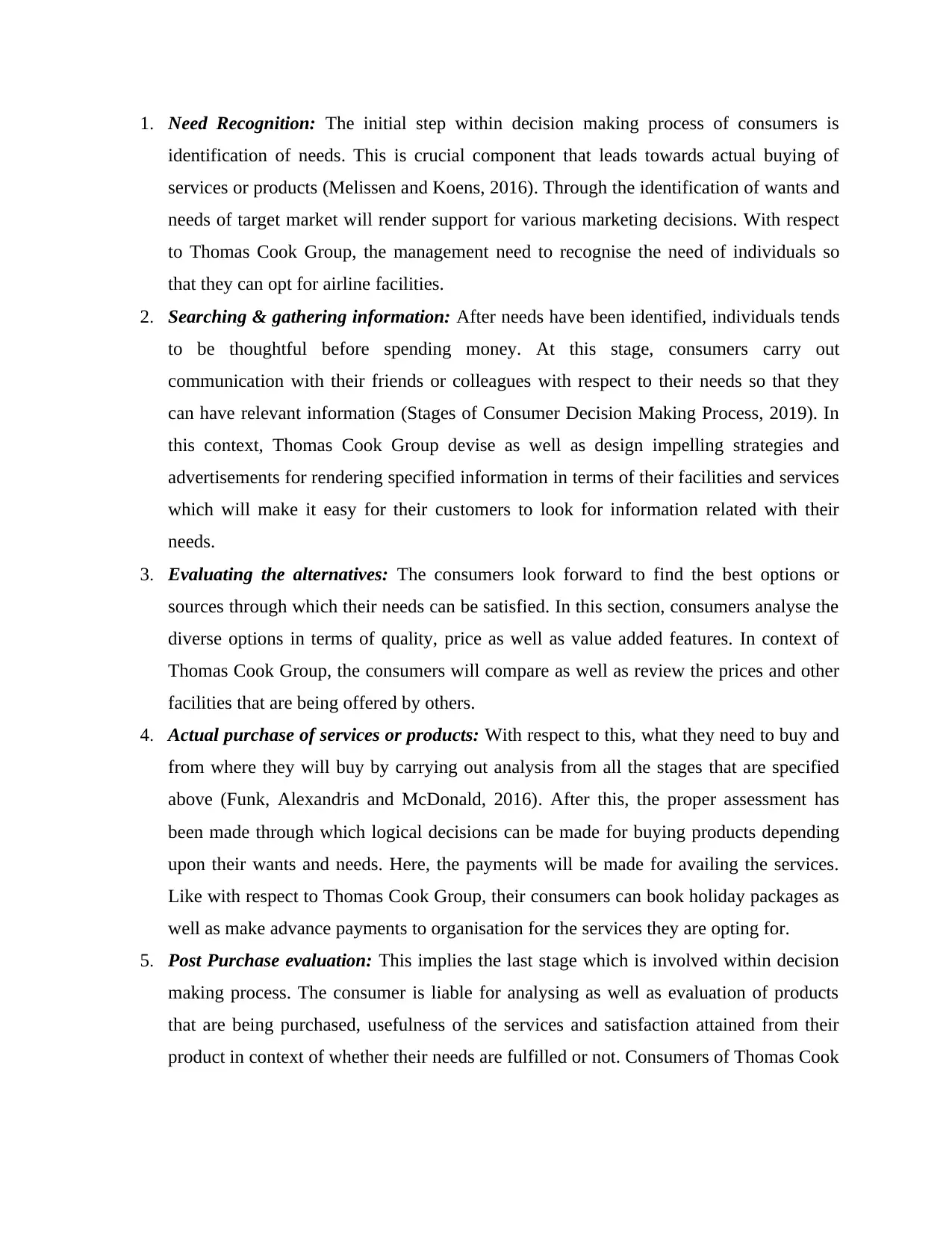
1. Need Recognition: The initial step within decision making process of consumers is
identification of needs. This is crucial component that leads towards actual buying of
services or products (Melissen and Koens, 2016). Through the identification of wants and
needs of target market will render support for various marketing decisions. With respect
to Thomas Cook Group, the management need to recognise the need of individuals so
that they can opt for airline facilities.
2. Searching & gathering information: After needs have been identified, individuals tends
to be thoughtful before spending money. At this stage, consumers carry out
communication with their friends or colleagues with respect to their needs so that they
can have relevant information (Stages of Consumer Decision Making Process, 2019). In
this context, Thomas Cook Group devise as well as design impelling strategies and
advertisements for rendering specified information in terms of their facilities and services
which will make it easy for their customers to look for information related with their
needs.
3. Evaluating the alternatives: The consumers look forward to find the best options or
sources through which their needs can be satisfied. In this section, consumers analyse the
diverse options in terms of quality, price as well as value added features. In context of
Thomas Cook Group, the consumers will compare as well as review the prices and other
facilities that are being offered by others.
4. Actual purchase of services or products: With respect to this, what they need to buy and
from where they will buy by carrying out analysis from all the stages that are specified
above (Funk, Alexandris and McDonald, 2016). After this, the proper assessment has
been made through which logical decisions can be made for buying products depending
upon their wants and needs. Here, the payments will be made for availing the services.
Like with respect to Thomas Cook Group, their consumers can book holiday packages as
well as make advance payments to organisation for the services they are opting for.
5. Post Purchase evaluation: This implies the last stage which is involved within decision
making process. The consumer is liable for analysing as well as evaluation of products
that are being purchased, usefulness of the services and satisfaction attained from their
product in context of whether their needs are fulfilled or not. Consumers of Thomas Cook
identification of needs. This is crucial component that leads towards actual buying of
services or products (Melissen and Koens, 2016). Through the identification of wants and
needs of target market will render support for various marketing decisions. With respect
to Thomas Cook Group, the management need to recognise the need of individuals so
that they can opt for airline facilities.
2. Searching & gathering information: After needs have been identified, individuals tends
to be thoughtful before spending money. At this stage, consumers carry out
communication with their friends or colleagues with respect to their needs so that they
can have relevant information (Stages of Consumer Decision Making Process, 2019). In
this context, Thomas Cook Group devise as well as design impelling strategies and
advertisements for rendering specified information in terms of their facilities and services
which will make it easy for their customers to look for information related with their
needs.
3. Evaluating the alternatives: The consumers look forward to find the best options or
sources through which their needs can be satisfied. In this section, consumers analyse the
diverse options in terms of quality, price as well as value added features. In context of
Thomas Cook Group, the consumers will compare as well as review the prices and other
facilities that are being offered by others.
4. Actual purchase of services or products: With respect to this, what they need to buy and
from where they will buy by carrying out analysis from all the stages that are specified
above (Funk, Alexandris and McDonald, 2016). After this, the proper assessment has
been made through which logical decisions can be made for buying products depending
upon their wants and needs. Here, the payments will be made for availing the services.
Like with respect to Thomas Cook Group, their consumers can book holiday packages as
well as make advance payments to organisation for the services they are opting for.
5. Post Purchase evaluation: This implies the last stage which is involved within decision
making process. The consumer is liable for analysing as well as evaluation of products
that are being purchased, usefulness of the services and satisfaction attained from their
product in context of whether their needs are fulfilled or not. Consumers of Thomas Cook
⊘ This is a preview!⊘
Do you want full access?
Subscribe today to unlock all pages.

Trusted by 1+ million students worldwide
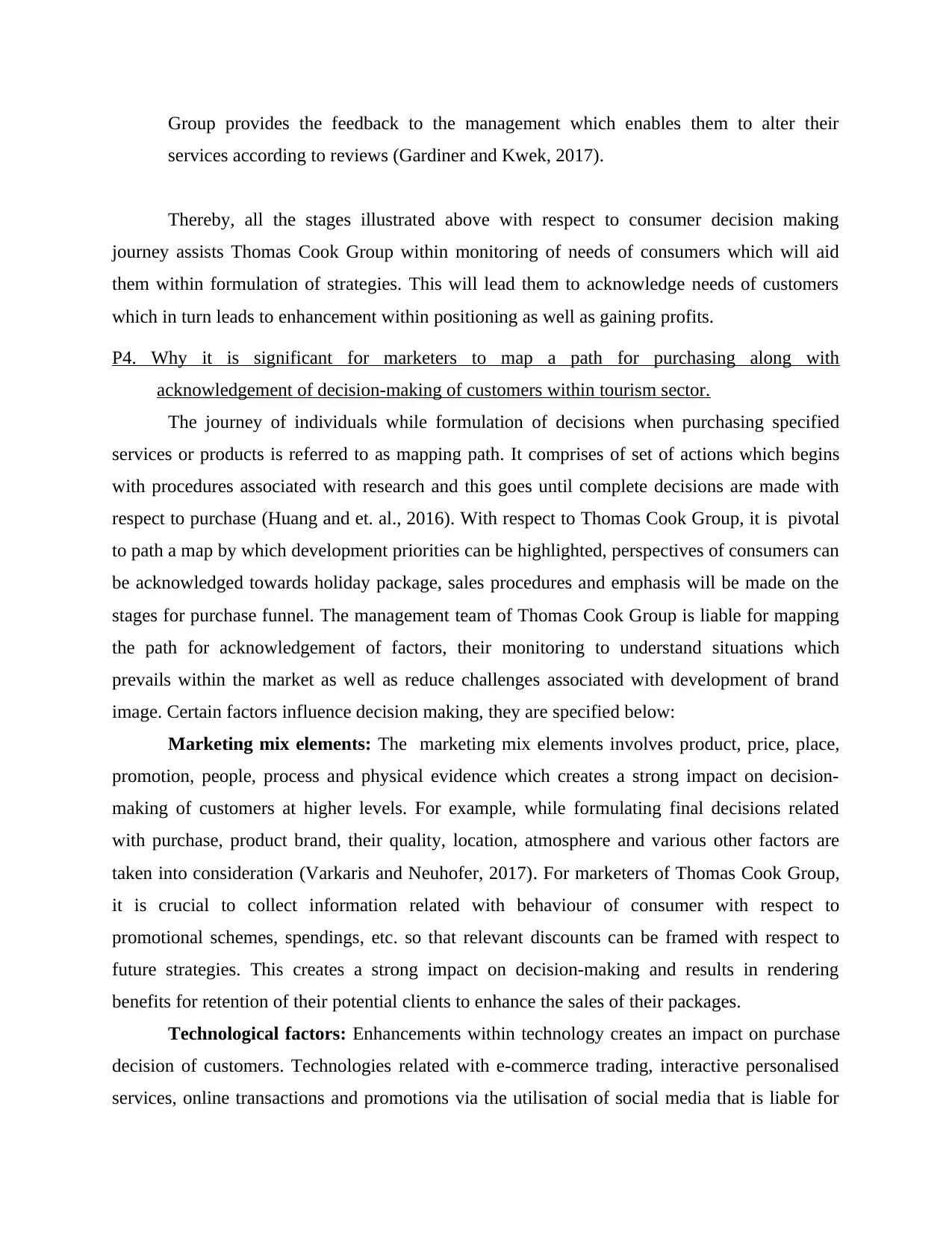
Group provides the feedback to the management which enables them to alter their
services according to reviews (Gardiner and Kwek, 2017).
Thereby, all the stages illustrated above with respect to consumer decision making
journey assists Thomas Cook Group within monitoring of needs of consumers which will aid
them within formulation of strategies. This will lead them to acknowledge needs of customers
which in turn leads to enhancement within positioning as well as gaining profits.
P4. Why it is significant for marketers to map a path for purchasing along with
acknowledgement of decision-making of customers within tourism sector.
The journey of individuals while formulation of decisions when purchasing specified
services or products is referred to as mapping path. It comprises of set of actions which begins
with procedures associated with research and this goes until complete decisions are made with
respect to purchase (Huang and et. al., 2016). With respect to Thomas Cook Group, it is pivotal
to path a map by which development priorities can be highlighted, perspectives of consumers can
be acknowledged towards holiday package, sales procedures and emphasis will be made on the
stages for purchase funnel. The management team of Thomas Cook Group is liable for mapping
the path for acknowledgement of factors, their monitoring to understand situations which
prevails within the market as well as reduce challenges associated with development of brand
image. Certain factors influence decision making, they are specified below:
Marketing mix elements: The marketing mix elements involves product, price, place,
promotion, people, process and physical evidence which creates a strong impact on decision-
making of customers at higher levels. For example, while formulating final decisions related
with purchase, product brand, their quality, location, atmosphere and various other factors are
taken into consideration (Varkaris and Neuhofer, 2017). For marketers of Thomas Cook Group,
it is crucial to collect information related with behaviour of consumer with respect to
promotional schemes, spendings, etc. so that relevant discounts can be framed with respect to
future strategies. This creates a strong impact on decision-making and results in rendering
benefits for retention of their potential clients to enhance the sales of their packages.
Technological factors: Enhancements within technology creates an impact on purchase
decision of customers. Technologies related with e-commerce trading, interactive personalised
services, online transactions and promotions via the utilisation of social media that is liable for
services according to reviews (Gardiner and Kwek, 2017).
Thereby, all the stages illustrated above with respect to consumer decision making
journey assists Thomas Cook Group within monitoring of needs of consumers which will aid
them within formulation of strategies. This will lead them to acknowledge needs of customers
which in turn leads to enhancement within positioning as well as gaining profits.
P4. Why it is significant for marketers to map a path for purchasing along with
acknowledgement of decision-making of customers within tourism sector.
The journey of individuals while formulation of decisions when purchasing specified
services or products is referred to as mapping path. It comprises of set of actions which begins
with procedures associated with research and this goes until complete decisions are made with
respect to purchase (Huang and et. al., 2016). With respect to Thomas Cook Group, it is pivotal
to path a map by which development priorities can be highlighted, perspectives of consumers can
be acknowledged towards holiday package, sales procedures and emphasis will be made on the
stages for purchase funnel. The management team of Thomas Cook Group is liable for mapping
the path for acknowledgement of factors, their monitoring to understand situations which
prevails within the market as well as reduce challenges associated with development of brand
image. Certain factors influence decision making, they are specified below:
Marketing mix elements: The marketing mix elements involves product, price, place,
promotion, people, process and physical evidence which creates a strong impact on decision-
making of customers at higher levels. For example, while formulating final decisions related
with purchase, product brand, their quality, location, atmosphere and various other factors are
taken into consideration (Varkaris and Neuhofer, 2017). For marketers of Thomas Cook Group,
it is crucial to collect information related with behaviour of consumer with respect to
promotional schemes, spendings, etc. so that relevant discounts can be framed with respect to
future strategies. This creates a strong impact on decision-making and results in rendering
benefits for retention of their potential clients to enhance the sales of their packages.
Technological factors: Enhancements within technology creates an impact on purchase
decision of customers. Technologies related with e-commerce trading, interactive personalised
services, online transactions and promotions via the utilisation of social media that is liable for
Paraphrase This Document
Need a fresh take? Get an instant paraphrase of this document with our AI Paraphraser
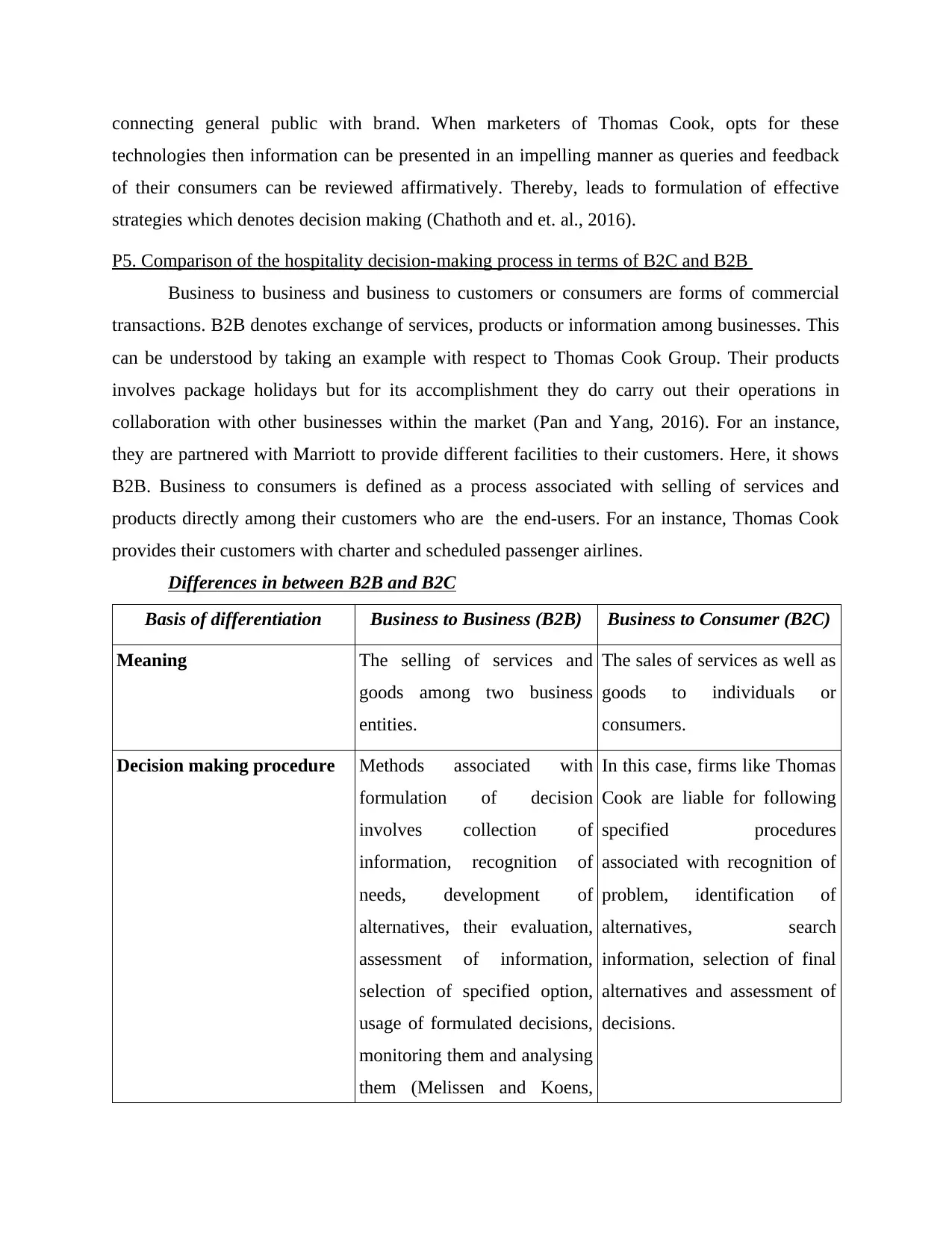
connecting general public with brand. When marketers of Thomas Cook, opts for these
technologies then information can be presented in an impelling manner as queries and feedback
of their consumers can be reviewed affirmatively. Thereby, leads to formulation of effective
strategies which denotes decision making (Chathoth and et. al., 2016).
P5. Comparison of the hospitality decision-making process in terms of B2C and B2B
Business to business and business to customers or consumers are forms of commercial
transactions. B2B denotes exchange of services, products or information among businesses. This
can be understood by taking an example with respect to Thomas Cook Group. Their products
involves package holidays but for its accomplishment they do carry out their operations in
collaboration with other businesses within the market (Pan and Yang, 2016). For an instance,
they are partnered with Marriott to provide different facilities to their customers. Here, it shows
B2B. Business to consumers is defined as a process associated with selling of services and
products directly among their customers who are the end-users. For an instance, Thomas Cook
provides their customers with charter and scheduled passenger airlines.
Differences in between B2B and B2C
Basis of differentiation Business to Business (B2B) Business to Consumer (B2C)
Meaning The selling of services and
goods among two business
entities.
The sales of services as well as
goods to individuals or
consumers.
Decision making procedure Methods associated with
formulation of decision
involves collection of
information, recognition of
needs, development of
alternatives, their evaluation,
assessment of information,
selection of specified option,
usage of formulated decisions,
monitoring them and analysing
them (Melissen and Koens,
In this case, firms like Thomas
Cook are liable for following
specified procedures
associated with recognition of
problem, identification of
alternatives, search
information, selection of final
alternatives and assessment of
decisions.
technologies then information can be presented in an impelling manner as queries and feedback
of their consumers can be reviewed affirmatively. Thereby, leads to formulation of effective
strategies which denotes decision making (Chathoth and et. al., 2016).
P5. Comparison of the hospitality decision-making process in terms of B2C and B2B
Business to business and business to customers or consumers are forms of commercial
transactions. B2B denotes exchange of services, products or information among businesses. This
can be understood by taking an example with respect to Thomas Cook Group. Their products
involves package holidays but for its accomplishment they do carry out their operations in
collaboration with other businesses within the market (Pan and Yang, 2016). For an instance,
they are partnered with Marriott to provide different facilities to their customers. Here, it shows
B2B. Business to consumers is defined as a process associated with selling of services and
products directly among their customers who are the end-users. For an instance, Thomas Cook
provides their customers with charter and scheduled passenger airlines.
Differences in between B2B and B2C
Basis of differentiation Business to Business (B2B) Business to Consumer (B2C)
Meaning The selling of services and
goods among two business
entities.
The sales of services as well as
goods to individuals or
consumers.
Decision making procedure Methods associated with
formulation of decision
involves collection of
information, recognition of
needs, development of
alternatives, their evaluation,
assessment of information,
selection of specified option,
usage of formulated decisions,
monitoring them and analysing
them (Melissen and Koens,
In this case, firms like Thomas
Cook are liable for following
specified procedures
associated with recognition of
problem, identification of
alternatives, search
information, selection of final
alternatives and assessment of
decisions.
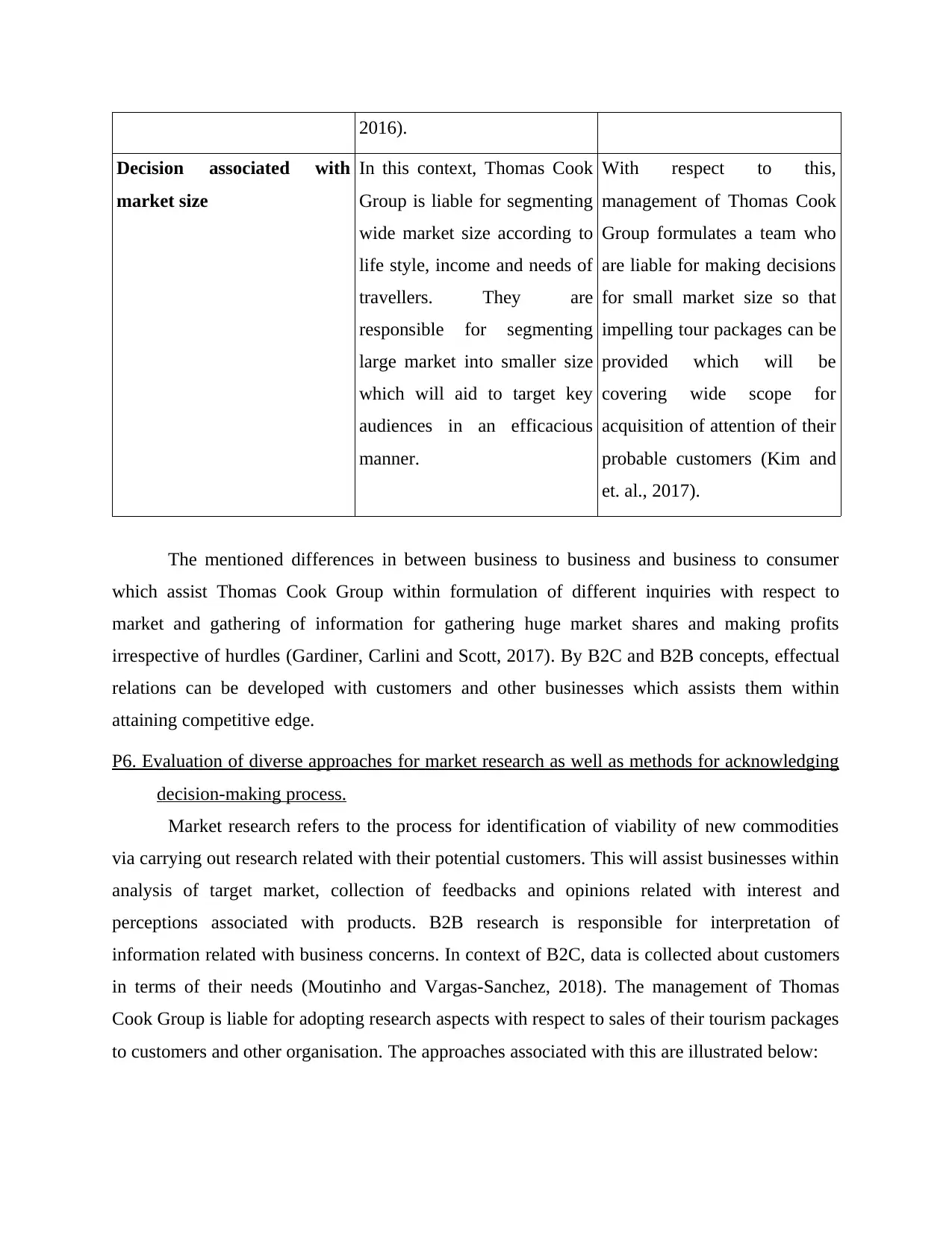
2016).
Decision associated with
market size
In this context, Thomas Cook
Group is liable for segmenting
wide market size according to
life style, income and needs of
travellers. They are
responsible for segmenting
large market into smaller size
which will aid to target key
audiences in an efficacious
manner.
With respect to this,
management of Thomas Cook
Group formulates a team who
are liable for making decisions
for small market size so that
impelling tour packages can be
provided which will be
covering wide scope for
acquisition of attention of their
probable customers (Kim and
et. al., 2017).
The mentioned differences in between business to business and business to consumer
which assist Thomas Cook Group within formulation of different inquiries with respect to
market and gathering of information for gathering huge market shares and making profits
irrespective of hurdles (Gardiner, Carlini and Scott, 2017). By B2C and B2B concepts, effectual
relations can be developed with customers and other businesses which assists them within
attaining competitive edge.
P6. Evaluation of diverse approaches for market research as well as methods for acknowledging
decision-making process.
Market research refers to the process for identification of viability of new commodities
via carrying out research related with their potential customers. This will assist businesses within
analysis of target market, collection of feedbacks and opinions related with interest and
perceptions associated with products. B2B research is responsible for interpretation of
information related with business concerns. In context of B2C, data is collected about customers
in terms of their needs (Moutinho and Vargas-Sanchez, 2018). The management of Thomas
Cook Group is liable for adopting research aspects with respect to sales of their tourism packages
to customers and other organisation. The approaches associated with this are illustrated below:
Decision associated with
market size
In this context, Thomas Cook
Group is liable for segmenting
wide market size according to
life style, income and needs of
travellers. They are
responsible for segmenting
large market into smaller size
which will aid to target key
audiences in an efficacious
manner.
With respect to this,
management of Thomas Cook
Group formulates a team who
are liable for making decisions
for small market size so that
impelling tour packages can be
provided which will be
covering wide scope for
acquisition of attention of their
probable customers (Kim and
et. al., 2017).
The mentioned differences in between business to business and business to consumer
which assist Thomas Cook Group within formulation of different inquiries with respect to
market and gathering of information for gathering huge market shares and making profits
irrespective of hurdles (Gardiner, Carlini and Scott, 2017). By B2C and B2B concepts, effectual
relations can be developed with customers and other businesses which assists them within
attaining competitive edge.
P6. Evaluation of diverse approaches for market research as well as methods for acknowledging
decision-making process.
Market research refers to the process for identification of viability of new commodities
via carrying out research related with their potential customers. This will assist businesses within
analysis of target market, collection of feedbacks and opinions related with interest and
perceptions associated with products. B2B research is responsible for interpretation of
information related with business concerns. In context of B2C, data is collected about customers
in terms of their needs (Moutinho and Vargas-Sanchez, 2018). The management of Thomas
Cook Group is liable for adopting research aspects with respect to sales of their tourism packages
to customers and other organisation. The approaches associated with this are illustrated below:
⊘ This is a preview!⊘
Do you want full access?
Subscribe today to unlock all pages.

Trusted by 1+ million students worldwide
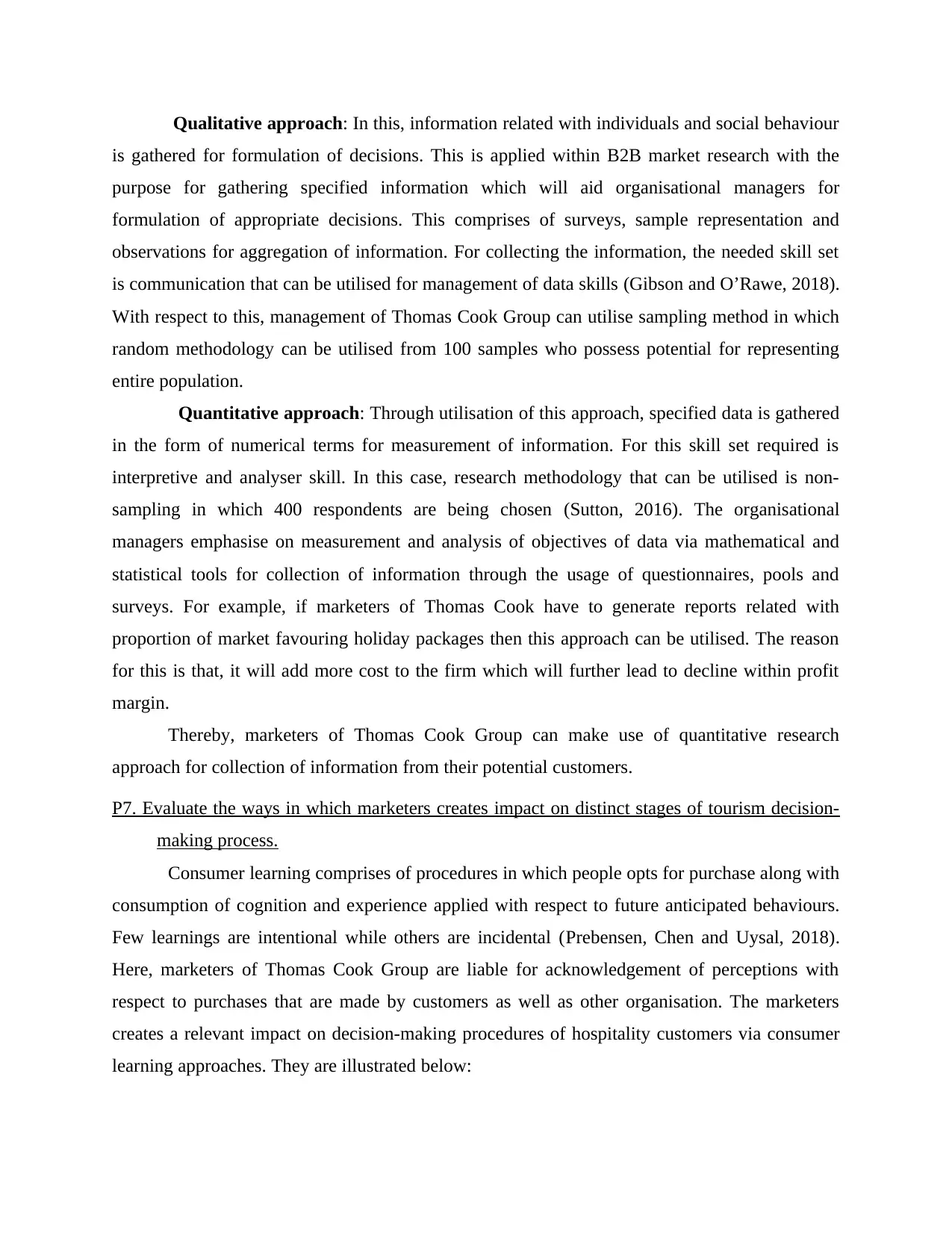
Qualitative approach: In this, information related with individuals and social behaviour
is gathered for formulation of decisions. This is applied within B2B market research with the
purpose for gathering specified information which will aid organisational managers for
formulation of appropriate decisions. This comprises of surveys, sample representation and
observations for aggregation of information. For collecting the information, the needed skill set
is communication that can be utilised for management of data skills (Gibson and O’Rawe, 2018).
With respect to this, management of Thomas Cook Group can utilise sampling method in which
random methodology can be utilised from 100 samples who possess potential for representing
entire population.
Quantitative approach: Through utilisation of this approach, specified data is gathered
in the form of numerical terms for measurement of information. For this skill set required is
interpretive and analyser skill. In this case, research methodology that can be utilised is non-
sampling in which 400 respondents are being chosen (Sutton, 2016). The organisational
managers emphasise on measurement and analysis of objectives of data via mathematical and
statistical tools for collection of information through the usage of questionnaires, pools and
surveys. For example, if marketers of Thomas Cook have to generate reports related with
proportion of market favouring holiday packages then this approach can be utilised. The reason
for this is that, it will add more cost to the firm which will further lead to decline within profit
margin.
Thereby, marketers of Thomas Cook Group can make use of quantitative research
approach for collection of information from their potential customers.
P7. Evaluate the ways in which marketers creates impact on distinct stages of tourism decision-
making process.
Consumer learning comprises of procedures in which people opts for purchase along with
consumption of cognition and experience applied with respect to future anticipated behaviours.
Few learnings are intentional while others are incidental (Prebensen, Chen and Uysal, 2018).
Here, marketers of Thomas Cook Group are liable for acknowledgement of perceptions with
respect to purchases that are made by customers as well as other organisation. The marketers
creates a relevant impact on decision-making procedures of hospitality customers via consumer
learning approaches. They are illustrated below:
is gathered for formulation of decisions. This is applied within B2B market research with the
purpose for gathering specified information which will aid organisational managers for
formulation of appropriate decisions. This comprises of surveys, sample representation and
observations for aggregation of information. For collecting the information, the needed skill set
is communication that can be utilised for management of data skills (Gibson and O’Rawe, 2018).
With respect to this, management of Thomas Cook Group can utilise sampling method in which
random methodology can be utilised from 100 samples who possess potential for representing
entire population.
Quantitative approach: Through utilisation of this approach, specified data is gathered
in the form of numerical terms for measurement of information. For this skill set required is
interpretive and analyser skill. In this case, research methodology that can be utilised is non-
sampling in which 400 respondents are being chosen (Sutton, 2016). The organisational
managers emphasise on measurement and analysis of objectives of data via mathematical and
statistical tools for collection of information through the usage of questionnaires, pools and
surveys. For example, if marketers of Thomas Cook have to generate reports related with
proportion of market favouring holiday packages then this approach can be utilised. The reason
for this is that, it will add more cost to the firm which will further lead to decline within profit
margin.
Thereby, marketers of Thomas Cook Group can make use of quantitative research
approach for collection of information from their potential customers.
P7. Evaluate the ways in which marketers creates impact on distinct stages of tourism decision-
making process.
Consumer learning comprises of procedures in which people opts for purchase along with
consumption of cognition and experience applied with respect to future anticipated behaviours.
Few learnings are intentional while others are incidental (Prebensen, Chen and Uysal, 2018).
Here, marketers of Thomas Cook Group are liable for acknowledgement of perceptions with
respect to purchases that are made by customers as well as other organisation. The marketers
creates a relevant impact on decision-making procedures of hospitality customers via consumer
learning approaches. They are illustrated below:
Paraphrase This Document
Need a fresh take? Get an instant paraphrase of this document with our AI Paraphraser
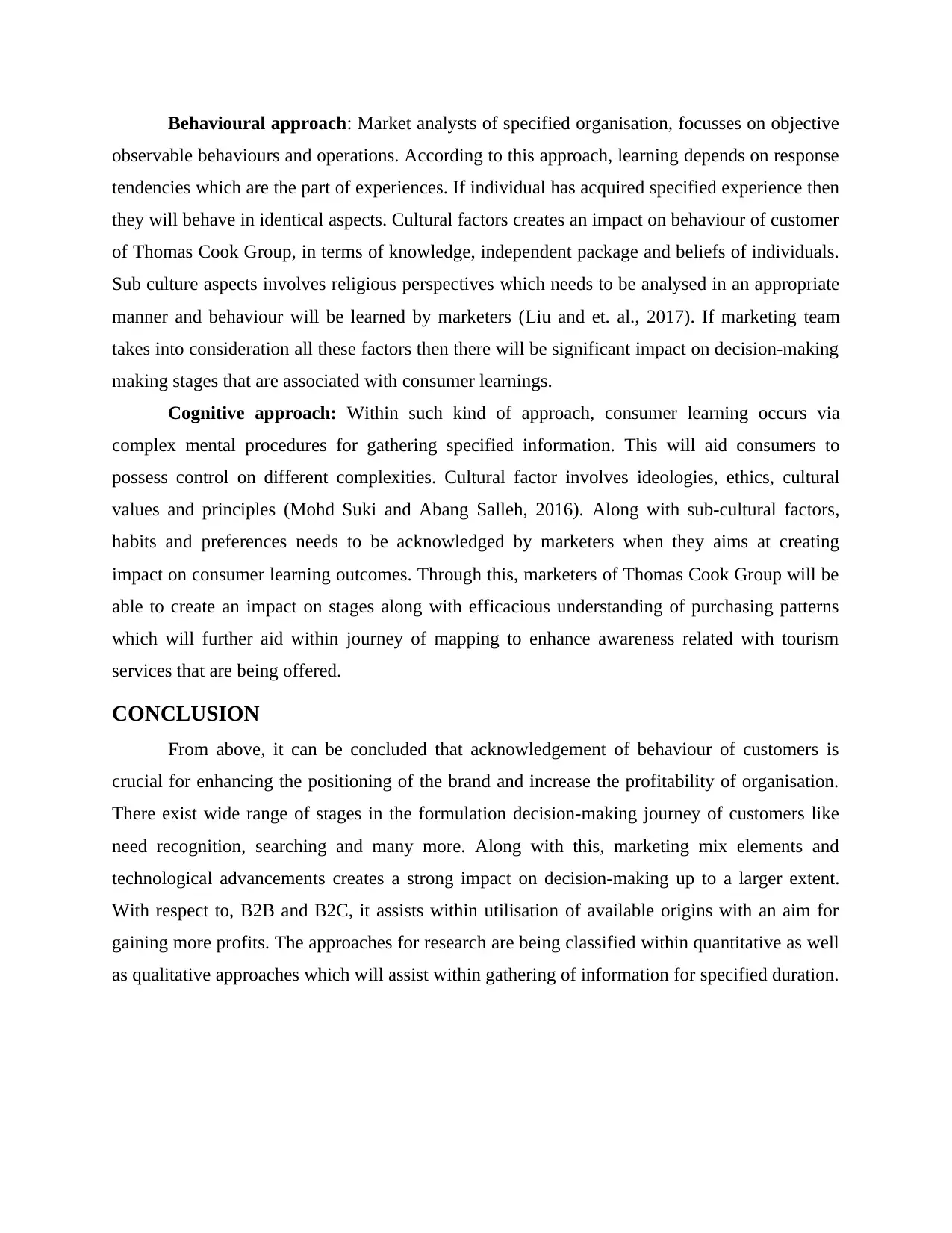
Behavioural approach: Market analysts of specified organisation, focusses on objective
observable behaviours and operations. According to this approach, learning depends on response
tendencies which are the part of experiences. If individual has acquired specified experience then
they will behave in identical aspects. Cultural factors creates an impact on behaviour of customer
of Thomas Cook Group, in terms of knowledge, independent package and beliefs of individuals.
Sub culture aspects involves religious perspectives which needs to be analysed in an appropriate
manner and behaviour will be learned by marketers (Liu and et. al., 2017). If marketing team
takes into consideration all these factors then there will be significant impact on decision-making
making stages that are associated with consumer learnings.
Cognitive approach: Within such kind of approach, consumer learning occurs via
complex mental procedures for gathering specified information. This will aid consumers to
possess control on different complexities. Cultural factor involves ideologies, ethics, cultural
values and principles (Mohd Suki and Abang Salleh, 2016). Along with sub-cultural factors,
habits and preferences needs to be acknowledged by marketers when they aims at creating
impact on consumer learning outcomes. Through this, marketers of Thomas Cook Group will be
able to create an impact on stages along with efficacious understanding of purchasing patterns
which will further aid within journey of mapping to enhance awareness related with tourism
services that are being offered.
CONCLUSION
From above, it can be concluded that acknowledgement of behaviour of customers is
crucial for enhancing the positioning of the brand and increase the profitability of organisation.
There exist wide range of stages in the formulation decision-making journey of customers like
need recognition, searching and many more. Along with this, marketing mix elements and
technological advancements creates a strong impact on decision-making up to a larger extent.
With respect to, B2B and B2C, it assists within utilisation of available origins with an aim for
gaining more profits. The approaches for research are being classified within quantitative as well
as qualitative approaches which will assist within gathering of information for specified duration.
observable behaviours and operations. According to this approach, learning depends on response
tendencies which are the part of experiences. If individual has acquired specified experience then
they will behave in identical aspects. Cultural factors creates an impact on behaviour of customer
of Thomas Cook Group, in terms of knowledge, independent package and beliefs of individuals.
Sub culture aspects involves religious perspectives which needs to be analysed in an appropriate
manner and behaviour will be learned by marketers (Liu and et. al., 2017). If marketing team
takes into consideration all these factors then there will be significant impact on decision-making
making stages that are associated with consumer learnings.
Cognitive approach: Within such kind of approach, consumer learning occurs via
complex mental procedures for gathering specified information. This will aid consumers to
possess control on different complexities. Cultural factor involves ideologies, ethics, cultural
values and principles (Mohd Suki and Abang Salleh, 2016). Along with sub-cultural factors,
habits and preferences needs to be acknowledged by marketers when they aims at creating
impact on consumer learning outcomes. Through this, marketers of Thomas Cook Group will be
able to create an impact on stages along with efficacious understanding of purchasing patterns
which will further aid within journey of mapping to enhance awareness related with tourism
services that are being offered.
CONCLUSION
From above, it can be concluded that acknowledgement of behaviour of customers is
crucial for enhancing the positioning of the brand and increase the profitability of organisation.
There exist wide range of stages in the formulation decision-making journey of customers like
need recognition, searching and many more. Along with this, marketing mix elements and
technological advancements creates a strong impact on decision-making up to a larger extent.
With respect to, B2B and B2C, it assists within utilisation of available origins with an aim for
gaining more profits. The approaches for research are being classified within quantitative as well
as qualitative approaches which will assist within gathering of information for specified duration.
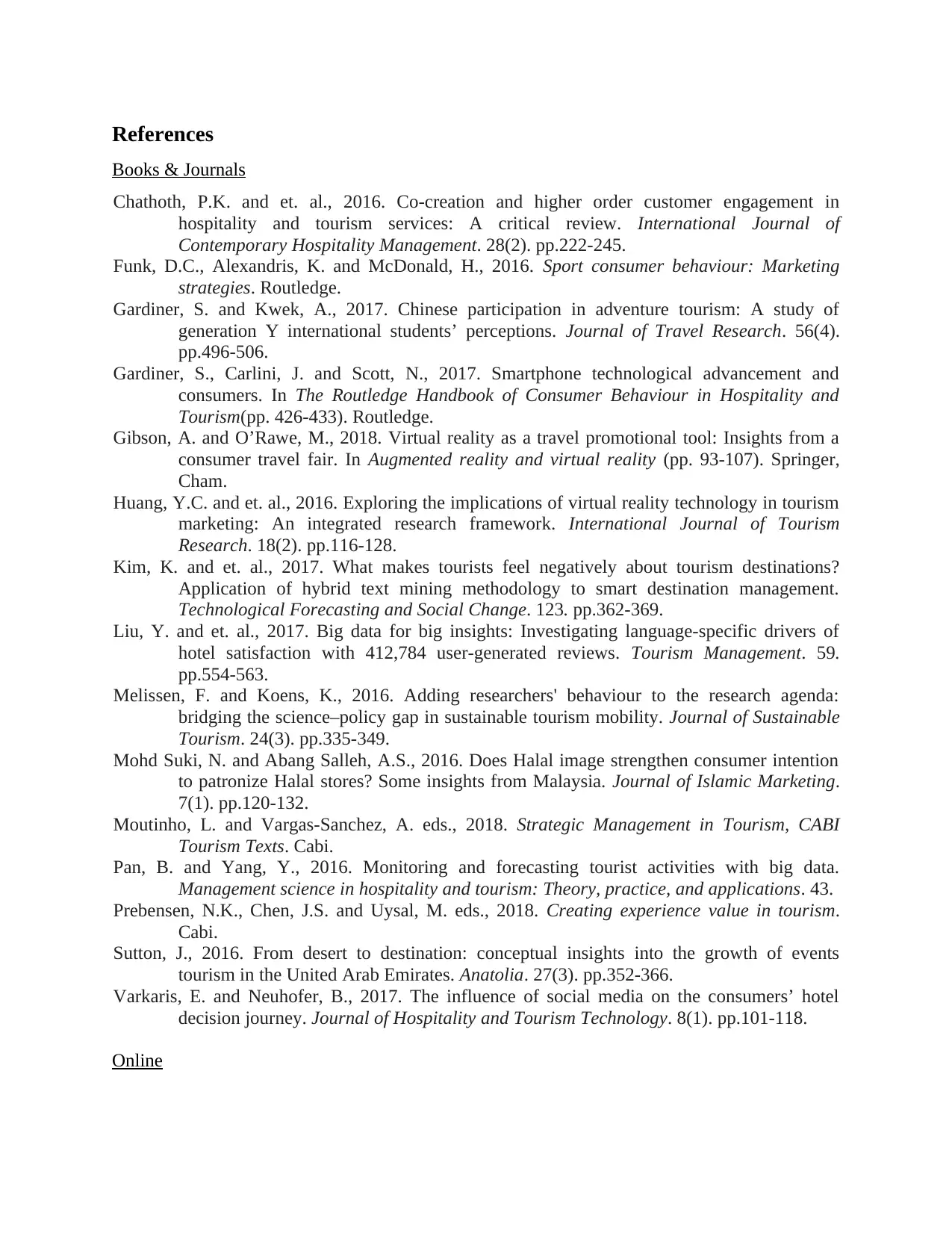
References
Books & Journals
Chathoth, P.K. and et. al., 2016. Co-creation and higher order customer engagement in
hospitality and tourism services: A critical review. International Journal of
Contemporary Hospitality Management. 28(2). pp.222-245.
Funk, D.C., Alexandris, K. and McDonald, H., 2016. Sport consumer behaviour: Marketing
strategies. Routledge.
Gardiner, S. and Kwek, A., 2017. Chinese participation in adventure tourism: A study of
generation Y international students’ perceptions. Journal of Travel Research. 56(4).
pp.496-506.
Gardiner, S., Carlini, J. and Scott, N., 2017. Smartphone technological advancement and
consumers. In The Routledge Handbook of Consumer Behaviour in Hospitality and
Tourism(pp. 426-433). Routledge.
Gibson, A. and O’Rawe, M., 2018. Virtual reality as a travel promotional tool: Insights from a
consumer travel fair. In Augmented reality and virtual reality (pp. 93-107). Springer,
Cham.
Huang, Y.C. and et. al., 2016. Exploring the implications of virtual reality technology in tourism
marketing: An integrated research framework. International Journal of Tourism
Research. 18(2). pp.116-128.
Kim, K. and et. al., 2017. What makes tourists feel negatively about tourism destinations?
Application of hybrid text mining methodology to smart destination management.
Technological Forecasting and Social Change. 123. pp.362-369.
Liu, Y. and et. al., 2017. Big data for big insights: Investigating language-specific drivers of
hotel satisfaction with 412,784 user-generated reviews. Tourism Management. 59.
pp.554-563.
Melissen, F. and Koens, K., 2016. Adding researchers' behaviour to the research agenda:
bridging the science–policy gap in sustainable tourism mobility. Journal of Sustainable
Tourism. 24(3). pp.335-349.
Mohd Suki, N. and Abang Salleh, A.S., 2016. Does Halal image strengthen consumer intention
to patronize Halal stores? Some insights from Malaysia. Journal of Islamic Marketing.
7(1). pp.120-132.
Moutinho, L. and Vargas-Sanchez, A. eds., 2018. Strategic Management in Tourism, CABI
Tourism Texts. Cabi.
Pan, B. and Yang, Y., 2016. Monitoring and forecasting tourist activities with big data.
Management science in hospitality and tourism: Theory, practice, and applications. 43.
Prebensen, N.K., Chen, J.S. and Uysal, M. eds., 2018. Creating experience value in tourism.
Cabi.
Sutton, J., 2016. From desert to destination: conceptual insights into the growth of events
tourism in the United Arab Emirates. Anatolia. 27(3). pp.352-366.
Varkaris, E. and Neuhofer, B., 2017. The influence of social media on the consumers’ hotel
decision journey. Journal of Hospitality and Tourism Technology. 8(1). pp.101-118.
Online
Books & Journals
Chathoth, P.K. and et. al., 2016. Co-creation and higher order customer engagement in
hospitality and tourism services: A critical review. International Journal of
Contemporary Hospitality Management. 28(2). pp.222-245.
Funk, D.C., Alexandris, K. and McDonald, H., 2016. Sport consumer behaviour: Marketing
strategies. Routledge.
Gardiner, S. and Kwek, A., 2017. Chinese participation in adventure tourism: A study of
generation Y international students’ perceptions. Journal of Travel Research. 56(4).
pp.496-506.
Gardiner, S., Carlini, J. and Scott, N., 2017. Smartphone technological advancement and
consumers. In The Routledge Handbook of Consumer Behaviour in Hospitality and
Tourism(pp. 426-433). Routledge.
Gibson, A. and O’Rawe, M., 2018. Virtual reality as a travel promotional tool: Insights from a
consumer travel fair. In Augmented reality and virtual reality (pp. 93-107). Springer,
Cham.
Huang, Y.C. and et. al., 2016. Exploring the implications of virtual reality technology in tourism
marketing: An integrated research framework. International Journal of Tourism
Research. 18(2). pp.116-128.
Kim, K. and et. al., 2017. What makes tourists feel negatively about tourism destinations?
Application of hybrid text mining methodology to smart destination management.
Technological Forecasting and Social Change. 123. pp.362-369.
Liu, Y. and et. al., 2017. Big data for big insights: Investigating language-specific drivers of
hotel satisfaction with 412,784 user-generated reviews. Tourism Management. 59.
pp.554-563.
Melissen, F. and Koens, K., 2016. Adding researchers' behaviour to the research agenda:
bridging the science–policy gap in sustainable tourism mobility. Journal of Sustainable
Tourism. 24(3). pp.335-349.
Mohd Suki, N. and Abang Salleh, A.S., 2016. Does Halal image strengthen consumer intention
to patronize Halal stores? Some insights from Malaysia. Journal of Islamic Marketing.
7(1). pp.120-132.
Moutinho, L. and Vargas-Sanchez, A. eds., 2018. Strategic Management in Tourism, CABI
Tourism Texts. Cabi.
Pan, B. and Yang, Y., 2016. Monitoring and forecasting tourist activities with big data.
Management science in hospitality and tourism: Theory, practice, and applications. 43.
Prebensen, N.K., Chen, J.S. and Uysal, M. eds., 2018. Creating experience value in tourism.
Cabi.
Sutton, J., 2016. From desert to destination: conceptual insights into the growth of events
tourism in the United Arab Emirates. Anatolia. 27(3). pp.352-366.
Varkaris, E. and Neuhofer, B., 2017. The influence of social media on the consumers’ hotel
decision journey. Journal of Hospitality and Tourism Technology. 8(1). pp.101-118.
Online
⊘ This is a preview!⊘
Do you want full access?
Subscribe today to unlock all pages.

Trusted by 1+ million students worldwide
1 out of 13
Related Documents
Your All-in-One AI-Powered Toolkit for Academic Success.
+13062052269
info@desklib.com
Available 24*7 on WhatsApp / Email
![[object Object]](/_next/static/media/star-bottom.7253800d.svg)
Unlock your academic potential
Copyright © 2020–2025 A2Z Services. All Rights Reserved. Developed and managed by ZUCOL.





